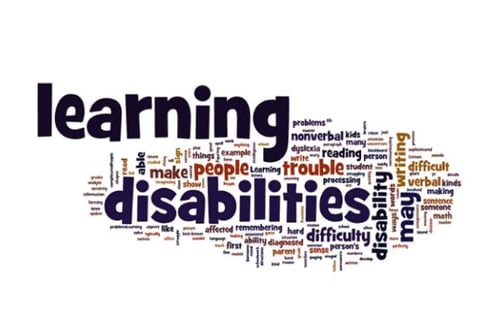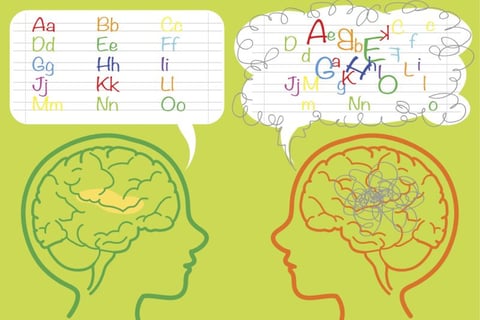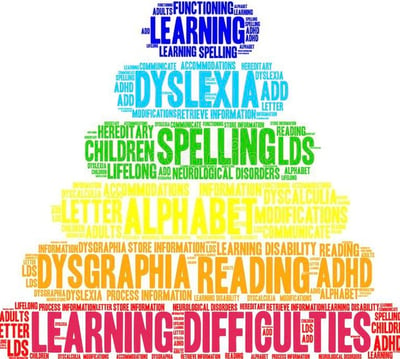
LEARNING DISABILITIES
LEARNING DISABILITIES
Learning disabilities are neurodevelopmental disorders that affect how individuals process, retain, and express information. At our learning disability center, we understand the unique challenges faced by those with learning disabilities and are dedicated to providing comprehensive support and resources. Our team of experienced professionals utilizes evidence-based strategies to assess, diagnose, and develop personalized intervention plans for individuals of all ages. Through individualized instruction, assistive technology, and specialized therapies, we empower individuals with learning disabilities to overcome obstacles, build confidence, and achieve academic success. Our goal is to create a nurturing and inclusive environment where individuals with learning disabilities can thrive, reach their full potential, and embrace their unique strengths. Contact us today to learn more about our services and how we can support you or your loved one on their learning journey.


DEFINTION
In the US, a committee of representatives of organizations committed to the education and welfare of individuals with learning disabilities is known as the National Joint Committee on Learning Disabilities (NJCLD). The NJCLD used the term 'learning disability' to indicate a discrepancy between a child's apparent capacity to learn and their level of achievement. Several difficulties existed, however, with the NJCLD standard of defining learning disability. One such difficulty was its belief of central nervous system dysfunction as a basis of understanding and diagnosing learning disability. This conflicted with the fact that many individuals who experienced central nervous system dysfunction, such as those with cerebral palsy, did not experience disabilities in learning. On the other hand, those individuals who experienced multiple handicapping conditions along with learning disability frequently received inappropriate assessment, planning, and instruction. The NJCLD notes that it is possible for learning disability to occur simultaneously with other handicapping conditions, however, the two should not be directly linked together or confused.


The effects of having a learning disability or learning difference are not limited to educational outcomes: individuals with learning disabilities may experience social problems as well. Neuropsychological differences can affect the accurate perception of social cues with peers.Researchers argue persons with learning disabilities not only experience negative effects as a result of their learning distinctions, but also as a result of carrying a stigmatizing label. It has generally been difficult to determine the efficacy of special education services because of data and methodological limitations. Emerging research suggests adolescents with learning disabilities experience poorer academic outcomes even compared to peers who began high school with similar levels of achievement and comparable behaviors. It seems their poorer outcomes may be at least partially due to the lower expectations of their teachers; national data show teachers hold expectations for students labeled with learning disabilities that are inconsistent with their academic potential (as evidenced by test scores and learning behaviors). It has been said that there is a strong connection between children with a learning disability and their educational performance.
Many studies have been done to assess the correlation between learning disability and self-esteem. These studies have shown that an individual's self-esteem is indeed affected by their own awareness of their learning disability. Students with a positive perception of their academic abilities generally tend to have higher self-esteem than those who do not, regardless of their actual academic achievement. However, studies have also shown that several other factors can influence self-esteem. Skills in non-academic areas, such as athletics and arts, improve self-esteem. Also, a positive perception of one's physical appearance has also been shown to have positive effects of self-esteem. Another important finding is that students with learning disabilities are able to distinguish between academic skill and intellectual capacity. This demonstrates that students who acknowledge their academic limitations but are also aware of their potential to succeed in other intellectual tasks see themselves as intellectually competent individuals, which increases their self-esteem.
Research involving individuals with learning disabilities who exhibit challenging behaviors who are subsequently treated with antipsychotic medications provides little evidence that any benefits outweigh the risk.
Effects OF Learning Disability

Causes
The causes for learning disabilities are not well understood, and sometimes there is no apparent cause for a learning disability. However, some causes of neurological impairments include:
Heredity and genetics: Learning disabilities are often linked through genetics and run in the family. Children who have learning disabilities often have parents who have the same struggles. Children of parents who had less than 12 years of school are more likely to have a reading disability. Some children have spontaneous mutations (i.e. not present in either parent) which can cause developmental disorders including learning disabilities. One studyestimated that about one in 300 children had such spontaneous mutations, for example a fault in the CDK13 gene which is associated with learning and communication difficulties in the children affected.
Problems during pregnancy and birth: A learning disability can result from anomalies in the developing brain, illness or injury. Risk factors are foetal exposure to alcohol or drugs and low birth weight (3 pounds or less). These children are more likely to develop a disability in math or reading. Children who are born prematurely, late, have a longer labor than usual, or have trouble receiving oxygen are more likely to develop a learning disability.
Accidents after birth: Learning disabilities can also be caused by head injuries, malnutrition, or by toxic exposure (such as heavy metals or pesticides).
Diagnosis
IQ-achievement discrepancy
Learning disabilities can be identified by psychiatrists, speech language pathologists, school psychologists, clinical psychologists, counseling psychologists, neuropsychologists, speech language pathologists, and other learning disability specialists through a combination of intelligence testing, academic achievement testing, classroom performance, and social interaction and aptitude. Other areas of assessment may include perception, cognition, memory, attention, and language abilities. The resulting information is used to determine whether a child's academic performance is commensurate with their cognitive ability. If a child's cognitive ability is much higher than their academic performance, the student is often diagnosed with a learning disability. The DSM-IV and many school systems and government programs diagnose learning disabilities in this way (DSM-IV uses the term "disorder" rather than "disability").
Although the discrepancy model has dominated the school system for many years, there has been substantial criticism of this approach among researchers. Recent research has provided little evidence that a discrepancy between formally measured IQ and achievement is a clear indicator of LD.Furthermore, diagnosing on the basis of a discrepancy does not predict the effectiveness of treatment. Low academic achievers who do not have a discrepancy with IQ (i.e. their IQ scores are also low) appear to benefit from treatment just as much as low academic achievers who do have a discrepancy with IQ (i.e. their IQ scores are higher than their academic performance would suggest).
Since 1998 there have been attempts to create a reference index more useful than IQ to generate predicted scores on achievement tests. For example, for a student whose vocabulary and general knowledge scores matches their reading comprehension score a teacher could assume that reading comprehension can be supported through work in vocabulary and general knowledge. If the reading comprehension score is lower in the appropriate statistical sense it would be necessary to first rule out things like vision problems
Response to intervention
Much current research has focused on a treatment-oriented diagnostic process known as response to intervention (RTI). Researcher recommendations for implementing such a model include early screening for all students, placing those students who are having difficulty into research-based early intervention programs, rather than waiting until they meet diagnostic criteria. Their performance can be closely monitored to determine whether increasingly intense intervention results in adequate progress.Those who respond will not require further intervention. Those who do not respond adequately to regular classroom instruction (often called "Tier 1 instruction") and a more intensive intervention (often called "Tier 2" intervention) are considered "non-responders." These students can then be referred for further assistance through special education, in which case they are often identified with a learning disability. Some models of RTI include a third tier of intervention before a child is identified as having a learning disability.
A primary benefit of such a model is that it would not be necessary to wait for a child to be sufficiently far behind to qualify for assistance.This may enable more children to receive assistance before experiencing significant failure, which may, in turn, result in fewer children who need intensive and expensive special education services. In the United States, the 2004 reauthorization of the Individuals with Disabilities Education Act permitted states and school districts to use RTI as a method of identifying students with learning disabilities. RTI is now the primary means of identification of learning disabilities in Florida.
The process does not take into account children's individual neuropsychological factors such as phonological awareness and memory, that can inform design instruction. By not taking into account specific cognitive processes, RTI fails to inform educators about a students' relative strengths and weaknessesSecond, RTI by design takes considerably longer than established techniques, often many months to find an appropriate tier of intervention. Third, it requires a strong intervention program before students can be identified with a learning disability. Lastly, RTI is considered a regular education initiative and consists of members of general education teachers, in conjunction with other qualified professionals.Occupational therapists in particular can support students in the educational setting by helping children in academic and non-academic areas of school including the classroom, recess and meal time. They can provide strategies, therapeutic interventions, suggestions for adaptive equipment, and environmental modifications. Occupational therapists can work closely with the child's teacher and parents to facilitate educational goals specific to each child under an RTI and/or IEP.
Latino learners
Demographers in the United States report that there has been a significant increase in immigrant children in the United States over the past two decades. This information is vital because it has been and will continue to affect both students and how educators approach teaching methods. Various teaching strategies are more successful for students that are linguistic or culturally diverse versus traditional methods of teaching used for students whose first language is English. It is then also true that the proper way to diagnose a learning disability in English language learners (ELL) differs. In the United States, there has been a growing need to develop the knowledge and skills necessary to provide effective school psychological services, specifically for those professionals who work with immigrant populations.
Currently, there are no standardized guidelines for the process of diagnosing ELL with specific learning disabilities (SLD). This is a problem since many students will fall through the cracks as educators are unable to clearly assess if a student's delay is due to a language barrier or true learning disability. Without a clear diagnosis, many students will suffer because they will not be provided with the tools they need to succeed in the public education school system. For example, in many occasions teachers have suggested retention or have taken no action at all when they lack experience working with English language learners. Students were commonly pushed toward testing, based on an assumption that their poor academic performance or behavioral difficulties indicated a need for special education. Linguistically responsive psychologist understand that second language acquisition is a process and they understand how to support ELLs' growth in language and academically. When ELLs are referred for a psychoeducational assessment, it is difficult to isolate and disentangle what are the effects of the language acquisition process, from poor quality educational services, from what may be academic difficulties that result from processing disorders, attention problems, and learning disabilities. Additionally not having trained staff and faculty becomes more of an issue when staff is unaware of numerous types of psychological factors that immigrant children in the U.S. could be potentially dealing with. These factors that include acculturation, fear and/or worry of deportation, separation from social supports such as parents, language barriers, disruptions in learning experiences, stigmatization, economic challenge, and risk factors associated with poverty.In the United States, there are no set policies mandating that all districts employ bilingual school psychologist, nor are schools equipped with specific tools and resources to assist immigrant children and families. Many school districts do not have the proper personnel that is able to communicate with this population.
speaking ELL
A well trained bilingual school psychologist will be able to administer and interpret assessments using psychological testing tools. Also, an emphasis is placed on informal assessment measures such as language samples, observations, interviews, and rating scales as well as curriculum-based measurement to complement information gathered from formal assessments.A compilation of these tests is used to assess whether an ELL student has a learning disability or merely is academically delayed because of language barriers or environmental factors. Many schools do not have a school psychologist with the proper training nor access to appropriate tools. Also, many school districts frown upon taking the appropriate steps to diagnosing ELL students.
Assessment
Many normed assessments can be used in evaluating skills in the primary academic domains: reading, including word recognition, fluency, and comprehension; mathematics, including computation and problem solving; and written expression, including handwriting, spelling and composition.
The most commonly used comprehensive achievement tests include the Woodcock-Johnson IV (WJ IV), Wechsler Individual Achievement Test II (WIAT II), the Wide Range Achievement Test III (WRAT III), and the Stanford Achievement Test–10th edition. These tests include measures of many academic domains that are reliable in identifying areas of difficulty.
In the reading domain, there are also specialized tests that can be used to obtain details about specific reading deficits. Assessments that measure multiple domains of reading include Gray's Diagnostic Reading Tests–2nd edition (GDRT II) and the Stanford Diagnostic Reading Assessment. Assessments that measure reading subskills include the Gray Oral Reading Test IV – Fourth Edition (GORT IV), Gray Silent Reading Test, Comprehensive Test of Phonological Processing (CTOPP), Tests of Oral Reading and Comprehension Skills (TORCS), Test of Reading Comprehension 3 (TORC-3), Test of Word Reading Efficiency (TOWRE), and the Test of Reading Fluency. A more comprehensive list of reading assessments may be obtained from the Southwest Educational Development Laboratory.
The purpose of assessment is to determine what is needed for intervention, which also requires consideration of contextual variables and whether there are comorbid disorders that must also be identified and treated, such as behavioral issues or language delays.These contextual variables are often assessed using parent and teacher questionnaire forms that rate the students' behaviors and compares them to standardized norms.
However, caution should be made when suspecting the person with a learning disability may also have dementia, especially as people with Down's syndrome may have the neuroanatomical profile but not the associated clinical signs and symptoms.Examination can be carried out of executive functioning as well as social and cognitive abilities but may need adaptation of standardized tests to take account of special needs



Let's talk
Head Office (Chidambaram)
No:2/46, 2nd Main Road,Kanagasabai Nagar,Chidambaram-608001,Cuddalore Dist,Tamil Nadu,
+91 9942032893 / +91 9488476165


